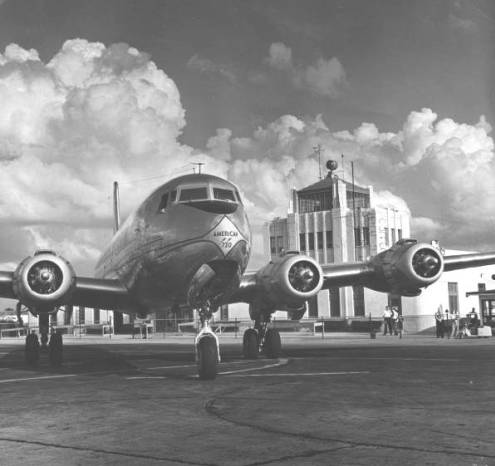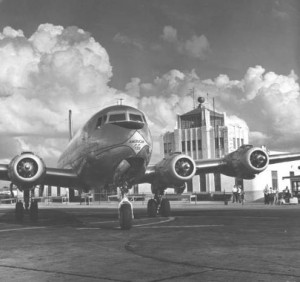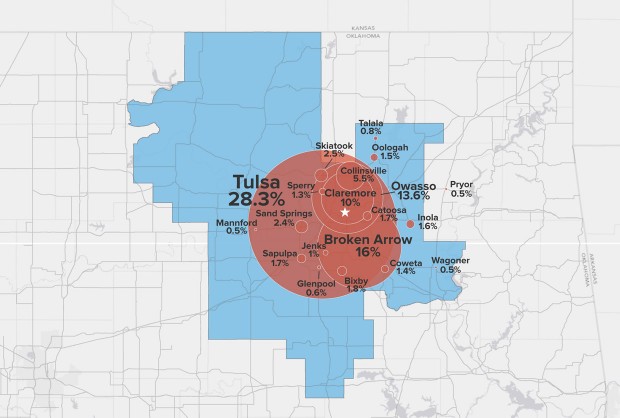
American Airlines D-6 at the Tulsa Municipal Airport flight line in 1945.
Beryl Ford Collection/Tulsa City-County Library


American Airlines D-6 at the Tulsa Municipal Airport flight line in 1945.
Beryl Ford Collection/Tulsa City-County Library

Beryl Ford Collection/Tulsa City-County Library
American Airlines D-6 at the Tulsa Municipal Airport flight line in 1945.
American Airlines in February detailed a bankruptcy-restructuring plan that eliminated 2,100 jobs from its Tulsa maintenance base.
Workers are worried about their jobs, and business leaders are concerned layoffs could mean losing about 10 percent of the area’s aerospace workforce.
And while the bulk of the base’s employees live in big-city Tulsa, the bankruptcy could have a much bigger impact on small towns, data show.
American Airlines’ parent, AMR Corp., filed for Chapter 11 bankruptcy protection in November 2011. The company and its unions have been battling in bankruptcy court over labor contracts, which the airline wants to terminate.
Meanwhile, US Airways is seeking a merger, and is wooing American’s unions with favorable labor agreements. The Transport Workers Union, which represents workers at the Tulsa Maintenance and Engineering Center, says the proposed merger would mean fewer job cuts.
American’s executives aren’t interested in a merger, at least until they’ve emerged from bankruptcy restructuring, and there’s skepticism of US Airways’ proposal materializing.
“I’ve seen nothing that would lead me to believe that they’re going to be successful,” Mike Neal, president of the Tulsa Metro Chamber, says about the proposed merger.

Graphic by Joe Wertz / Source: Tulsa Metro Chamber/American Airlines
This map shows the per-capita impact of American Airlines jobs in northeastern Oklahoma. Click for a larger version.
The Tulsa Maintenance and Engineering Center is the airline’s largest, and has been a part of the company’s operations for more than 50 years.
The base employs about 7,000 people — mostly mechanics — and it’s the largest manufacturing employer in the Tulsa region. The base is the second-largest employer in northeastern Oklahoma, Neal says.
The most workers — about 1,800 — live in Tulsa, according to 2011 numbers the Tulsa Metro Chamber received from the airline. About as many of the airline’s workers live in Broken Arrow and Owasso, the data show.

Graphic: Joe Wertz / Source: Tulsa Metro Chamber | American Airlines
This map shows where American Airlines' workers live in northeastern Oklahoma. Click for a larger version.
But hundreds of the airline’s workers live in small towns like Inola, Oologah and Talala, where symptoms of job losses could be most-readily felt.
In Talala, nearly one in five people work for the airline, the data show. There’s not much to the town of 270 people.
More than 50 Talala locals worked at American’s Tulsa base in August 2011, data show, but Mayor Lester Orwig says it’s unlikely that layoffs would have much impact on the town, which he says is basically a grocery store and gas station surrounded by a large rural mail route.
The mayor of nearby Oologah, however, says he’s worried.

Spencer Platt / Getty Images
American Airlines and American Eagle employees rally in front of the U.S. Bankruptcy Court to protest against American's plans to cut jobs and labor costs while under bankruptcy court protection.
“The American Airlines bankruptcy probably will have a big impact on us,” says Jerry Holland.
More than 8 percent of Oologah — population: 1,100 — works for the airline, data show. The town has been growing, Holland says. A new town hall, “high-tech” library and senior center are in the works, and townspeople there are buzzing about the bankruptcy. Holland says his neighbor is a long-time American Airlines mechanic.
Naturally, the workers and their families are worried about losing their jobs, Holland says. American Airlines employed about 100 people from Oologah in 2011, data show, but Holland is more worried about the type of jobs that could be lost in the airline’s bankruptcy than the total number.
“They’re high-paying jobs,” he says.
The average manufacturing worker in the Tulsa metro earned about $39,400 in 2011, the Tulsa World reports, citing data from the Bureau of Labor Statistics.
But the average maintenance worker at American Airlines made $65,892 in 2010, according to the Airline Data Project, prepared by researchers at the Massachusetts Institute of Technology.
Overall, incomes in Oologah are relatively high. Holland says that’s because of the American Airlines’ jobs.
“There are jobs around here, but not these kinds of jobs,” he says. “The concern is moving from a $50 per-hour job with a pension and good benefits to a $20 per-hour job with no benefits.”